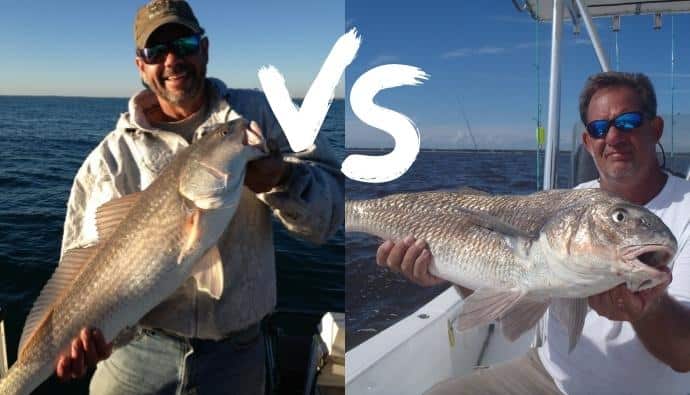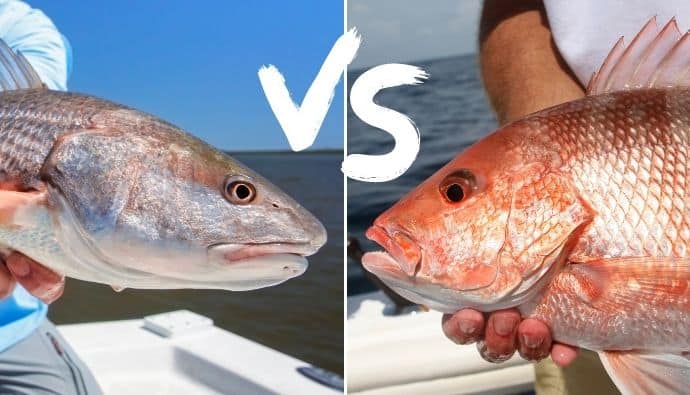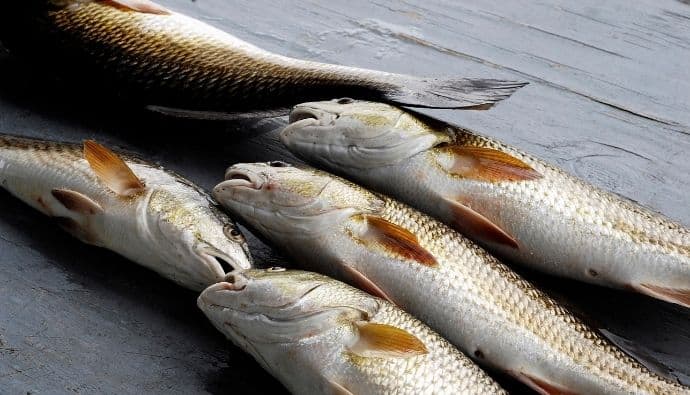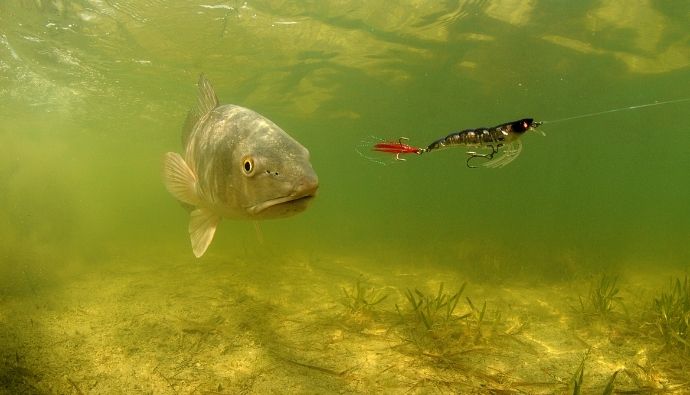Like the Jolly Rogers sticking above the pirate ship mast, a spotted tail finning its way through shallow water on an early morning sends shivers down the spine of every angler.
It’s the redfish his way of saying “take no prisoners” to any baitfish, crabs, and other prey hiding in the shallows in search of defilade from these coppery-gold marauders.
The truth is, there is very little that will stand in the way of a redfish and its prey.
Flyfishermen and other anglers can use this to their advantage and make the most out of setting their sights on finning Redfish.
Here’s our guide to tailing Redfish.
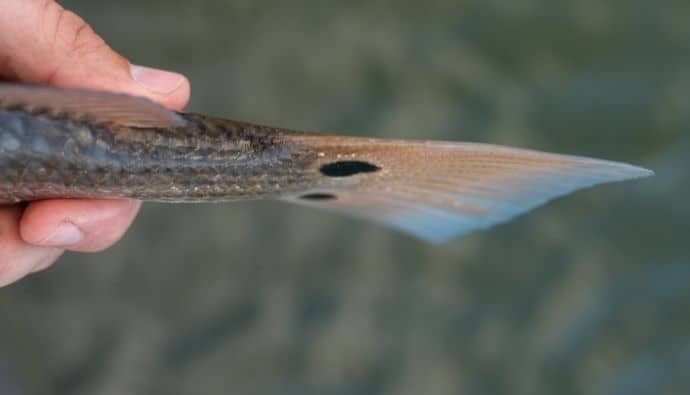
Finning
What is finning and where can you find it? For those new to angling for redfish, finning is when a Red drum finds itself in shallow water, and its tail rides out of the surface.
This often occurs in cooler months, when the Redfish seek shallower water due to its warmth and prolific amounts of bait.
Often in backcountry waters, at less than depths of 2 feet, these predators can usually be found with a combination of three things. Lots of baitfish, moving water, and on a hard bottom.
Baitfish
Baitfish are the primary ingredient. When food sources are scarce, so are the redfish. Mullets are often indicative of the location of their red-colored predators.
While the larger mullet congregated in large schools disturb the bottom, disclosing crabs and shrimp, smaller mullets make an excellent snack for a hungry Redfish.
Moving Water
The second important aspect is moving water. Not only does this mean the water is oxygenated, but moving water often provides higher visibility than stationary water.
It also brings with it food sources as it provides transient bait for lurking redfish. Avoid stagnant or stationary water, as it is usually less oxygenated and will often have little to no fish.
Hard Bottom
Finally, a hard bottom is one of the most important pieces for finning Redfish. Scavengers, and redfish prefer not to have to search too far for their next meal.
Hard bottom locations with sparse grass are excellent locations, as fish may bump into the jutting foliage, signaling their presents. Mud minnows that inhabit these grass upshots are favorites of Redfish and should be capitalized on as bait.
Finning or tailing most often occurs at two points during the day. That would be early morning and just before dark. As these are the most common times anglers will find success in general, it’s important to start one’s boat-born escapades scouring the shallows for tailing reds.
There are five easy steps, from identifying a tailing Redfish to bringing it into the boat.
Sighting
Now that the reader knows what to look for, it’s important to be on the lookout for tails protruding above the water. Heading to shallow, moving backwaters that are bait rich should be an angler’s first move.
Once there, settling the boat down to trolling or cutting the motor within casting distance from the shore is the next step.
Provide the water the opportunity to calm down and adjust to your presence. Getting too close to the target area, no matter how much easier it makes casting, can spook the fish and destroy one’s chances.
Insider Advice: Identify the flats and grass upshots around your location that may be viable options for Redfish. It may take a minute or so, but eventually, if you are in the correct spot, tails will appear.
Maneuver
Once a redfish is spotted, it is the angler’s job to maneuver it within striking distance. Trolling motors can make quite a disturbance when maneuvering on the fish, therefore, push poles are recommended.
Push poles are carbon fiber, fiberglass, or graphite poles that are utilized to maneuver the boat in shallow water. I recommend the Pelican Anchor and Push Pole and Yak Attack ParkNPole.
Bamboo, PVC pipes, or wooden dowels can be just as effective in bringing a boat from point A to B, so there is no need to go spend an extraordinary amount of money.
When polling, avoid hull slaps. This occurs when water strikes the hull and can give away an angler’s position.
To mitigate noise, turn off bilge pumps, live wells, or any other mechanical device that may create noise and watch your polling strokes.
Insider Advice: If the angler does not have a pole or other factors prevent access of this nature, taking the boat upwind and drifting down is also a technique.
Casting
This initial step may be the most crucial one in catching a tailing redfish. Casting in too close of proximity to the fish will result in the creature spooking, and you’ve lost your opportunity. Therefore, there are two methods of bait placement that will allow for maximum effectiveness.
The first is casting to the tail. This entails (pun intended) determining the direction of movement which the fish is taking and then casting 2 feet in front of where the head is speculated to be.
This allows for some distance between the splash of one’s lure or bait and the Drum’s head.
Remember, placing the lure, fly or bait directly on top of the fish’s nose is counterproductive.
They have excellent eyesight and can observe incoming object, and will take off well before it strikes the intended target. Instead, 2 feet in front of the eyes is plenty of space.
The second option is casting well in front of the redfish and dragging the lure or bait in a non-suspicious fashion. This mitigates the risk of spooking the fish. However, it’s not always guaranteed that the redfish will pick up on it from the start.
Both are viable options. It is up to the discretion of the angler which one to use.
Insider Advice: Always overcast, under casting will often spook the fish or strike it directly.
Retrieval
Once the bait, lure, or fly is in the water, it’s game on.
If the angler has chosen the first method of casting, it’s important to allow the bait or lure to sit for a second. The fish must acclimate to its presence and then choose whether to pursue it.
Sometimes they may strike instantaneously, however, with dead or live bait such as shrimp or crabs. It may take them a moment to catch its scent.
If utilizing artificial bait, light twitching is recommended to simulate a wounded or dying baitfish.
If the second method of casting is incorporated, movement is a necessary part of this technique. The angler must bring the bait near the fish or through its periphery to garner its interest.
Obnoxious, overt movements may spook the fish in shallow water. Therefore, small twitches with a slow, steady retrieval are optimal for luring the fish in.
Insider Advice: Up the levels of movement if the fish fails to notice the light twitches. An injured or dying fish makes an easy meal and needs to look believable.
If, at first, you don’t succeed…
Robert Bruce’s adage, “If at first you don’t succeed, try try again,” is apropos of angling for tailing redfish. It could be the wrong bait, the cast could be wrong, the fish may be full, or it’s entirely possible the angler spooked them.
However, this does not mean it’s time to call it a day. Any angler worth their salt should have a tackle box full of tricks.
Varying up lures and baits, casting further out, or differing retrieval techniques will all benefit anglers who have not struck gold in the shallows yet.
Adjusting the direction of the rod tip pointing during retrieval can make all the difference. By pointing to the left or the right, the direction of the bait’s movement will change completely and bring it into the drum’s path.
This works well when casting past the redfish. Slight adjustments can be made as to the fish and lure or bait coming face to face on a collision course.
Pay attention to what bait is available in the water around you. It could be that the lure being thrown or the bait that has been cast is not what the predator is snacking on currently.
Alternatively, switch between plastics and bait. It may be that whatever is being thrown is not the preference of the drum.
However, redfish are notoriously not picky eaters. Therefore, if the bait or lures are not working after several casts, it may be something other than what’s on the end of your line.
Repositioning is also something most anglers don’t take into consideration. If the current setup is not advantageous for the angler to casts into or around a specific spot, there is no shame in polling to a different location or packing up and moving altogether.
Angling for tailing or finning Redfish can be an enthralling experience. Once that spotted tail is observed, the game of waterborne cat and mouse begins.
Utilizing the proper bait and casting techniques, anglers can avail themselves of as many Redfish as the limit allows. It’s important to remember that boat position, the direction of the cast, and retrieval technique all matter significantly in catching a finning Redfish.
With the right position, a sharp eye, and a good cast, anglers will find themselves with a full ice chest calling it an early day. As always, best of luck. Stay safe on the water.

 Facebook
Facebook YouTube
YouTube